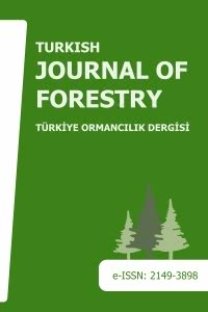Isıl işlem uygulanmış bazı ağaç malzemelerde yapışma direncinin belirlenmesi
Determination of bonding strength in heat treated some wood materials
___
- Altınok, M., 2002. Ahşap tutkallı birleştirmelerde yapışma performansına sıcaklık artışının etkileri. Politeknik Dergisi, 5(4) : 341-345.
- Atar, M., Örs, Y., 1999. Klebit 303, kleiberit 305.0 ve süper–lackleim 308 tutkallarının yapışma dirençleri. Turkish Journal of Agriculture and Forestry, 23(3): 757– 761.
- Atar, M., Özçifçi, A., Uysal, B., 1999. Ağaç malzemede renk açıcı kimyasal maddelerin PVAc tutkalının yapışma mukavemetine etkileri. Fen ve Mühendislik Bilimleri Dergisi, 11(1): 145-151.
- Atar, M., 2007. PVAc tutkalında viskozite değişiminin bazı ağaç malzemelerde yapışma direncine etkileri. Politeknik Dergisi, 10(1): 85-91.
- Bengtsson, C., Jermer, J., Clang, A., Ek-Olausson, B., 2003. Investigation of some technical properties of heat- treated wood. International Research Group On Wood Preservation, 18-23.
- BS EN 204, 1991. Non-structural adhesives for joining of wood and derived timber products. British Standarts, England.
- BS EN 205, 1991. Test methods for wood adhesives for non-structural applications- determination of tensile shear strength of lap joints. British Standards Institution, England.
- Change, C.I., Keith, C.T., 1978. Properties of heat-darkened wood. II- Mechanical properties and gluability. Fisheries and Environment, 1–19.
- Chow, S.Z., 1971. Infrared spectral characteristics and surface inactivation of wood at high temperatures. Wood Science Technology, 5:27-39.
- Doruk, Ş., 2010. Lamine ağaç malzemede vernik ve emprenye işlemlerinin yaşlandırmaya etkisinin belirlenmesi. Doktora Tezi, Gazi Üniversitesi, Fen Bilimleri Enstitüsü, Ankara.
- Follrich, J., Müller, U., Gindl, W., 2006. Effects of thermal modification on the adhesion between spruce wood (picea abies karst.) and a thermoplastic polymer. Holz Roh Werkst, 64: 373-376.
- Kleiberit, Aktif Yapıştırıcı ve Kimya Sanayi Ticaret A.Ş Kataloğu., 2013. http://www.aktifas.com.tr/kleiberitpvca beyaztutkallari.asp, Erişim: 04.04. 2013.
- Kol, H.Ş., Özbay. G., Altun. S., 2009. Shear strength of heat-treated tali (erythrophleum ivorense) and ıroko (chlorophora excelsa ) woods bonded with various adhesives. Bio Resources, 4(4): 1545-1554.
- Kolmann, F., Schneider, A., 1963. On the sorption behaviour of heat stabilized wood. Holz Roh-Werkst, 21(3): 77–85.
- Korkut, S., 2009. Gürgen yapraklı kayacık (ostrya carpinifolia scop.) odununun bazı mekanik özelikleri üzerine ısıl işlem sıcaklık ve süresinin etkisi. Düzce Üniversitesi, Ormancılık Dergisi, 5(1): 121-130.
- Mayes, D., Oksanen, O., 2002. Thermowood handbook. Finnforest, Finland.
- Örs.Y., Atar. M., Özçifçi.A., 1999. Farklı ağaç türleri ile yonga ve lif levhalarda PVAc veya Desmodur VTKA tutkalı kullanarak uygulanan kavelalarda çekme mukavemeti. Turkish Journal of Agriculture and Forestry, 1: 151-156.
- Örs, Y., Atar, M., Özçifçi, A., 2000. Bonding strength of poly(vinyl acetate)-based adhesives in some wood materials treated with impregnation. Journal of Applied Polymer Science, 76: 1472-1479.
- Özçifçi, A., Özen, R., Altınok, M., 1997. Determine of strength join of polimarin adhesive in boiling, cold and hot water conditions of wooden material. Dünya Ormancılık Kongresi, Antalya, s. 45-46.
- Özçifçi, A., Altun, S., Yapıcı, F., 2009. Isıl işlem uygulamasının ağaç malzemenin teknolojik özelliklerine etkisi. Uluslararası İleri Teknolojiler Sempozyumu, 13- 15 Mayıs, Karabük Üniversitesi, Karabük, s. 1169-1175.
- Petrissans, M., Gerardin, P., El Bakali, I., Serraj, M., 2003. Wettability of Heattreated Wood. Holzforsch, 57: 301- 307.
- Rapp, O, A., 2001. Rewiew on heat treatments of wood. Printed by The European Commission Research Directorate. Belgium, ISBN:3-926301-02-3.
- Rusche, H., 1973. Termal degradation of wood at temperatures up to 200oC, Part I, strength of dried wood after heat treatment. Holz Roh-und, Werkstoff, 31: 273- 281.
- Sernek, M., Kamke, F.A., Glasser, W.G., 2004. Comparative analysis of inactivated wood surface. Holzforschung, 58: 22-3.
- Sernek, M., Boonstra, M., Pizzi, A., Despres, A., Gerardin, P., 2008. Bonding performance of heat treated wood with structural adhesives. Holz Roh Werkst, 66(3): 173- 180.
- Sivonen, H., Maunu, S., Sundholm, F., Ja ̈msa, S., Viitaniemi, P., 2002. Magnetic resonance studies of thermally modified wood. Holzforschung, 56: 648–654.
- Söğütlü, C., Döngel, N., 2007. Polivinilasetat (PVAc) ve poliüretan (PU) tutkalları ile yapıştırılmış bazı yerli ağaçlarda çekmede makaslama dirençleri. Politeknik Dergisi, 10(3): 287-293.
- Stamm, A., Hansen, L., 1937. Minimizing wood shrinkage and swelling: effect of heating in various gases. Industrial Engineering Chemistry, 29(7) : 831–833.
- Tjeerdsma, B., Boonstra, M., Pizzi, A., Tekely, P., Militz, H., 1998. Characterisation of thermally modified wood: molecular reasons for wood performance improvement. Holz Roh-Werkst, 56: 149-153.
- TS 2472, 1972. Odunda fiziksel ve mekanik deneyler için birim hacim ağırlığı tayini. TSE, Ankara.
- Viitanen, H., Jämsä, S., Paajanen L., Nurmi, A., Viitaniemi, P., 1994. The effect of heat treatment on the properties of spruce. IRG/WP, 94-40032: 4.
- Vital, B R., Lucia, R M D., 1983. Effect of heating on some properties of eacalyptus saligna wood. Revista-Arvore, 7(2) :136-146.
- ISSN: 1302-7085
- Yayın Aralığı: Yılda 2 Sayı
- Başlangıç: 2000
Isıl işlem uygulanmış bazı ağaç malzemelerde yapışma direncinin belirlenmesi
MDF atıklarının odun plastik kompozitlerin üretiminde değerlendirilmesi
Nilgül ÖZMEN, NİHAT SAMİ ÇETİN, NASIR NARLIOĞLU, VEDAT ÇAVUŞ, ERTUĞRUL ALTUNTAŞ
Ormaniçi merada ağaç sıklığının bitki örtüsü üzerine etkileri
İLKER ERCANLI, Muammer ŞENYURT, Ferhat BOLAT
Ormanların heyelan oluşumu üzerindeki etkileri
Serbest ormancılık büroları ve orman mühendisi istihdamına etkisi
Atakan Öztürk, Ümit AKTAN, UFUK DEMİRCİ
Çimentolu yonga levhanın bazı özelliklerine rutubet değişimin etkisinin belirlenmesi
FATİH YAPICI, HÜSEYİN YÖRÜR, İLKER YALÇIN
Sürdürülebilir orman yönetimi ölçüt ve göstergelerinin Türkiye için modellenmesi
MUSTAFA YILMAZ, FATİH TONGUÇ, Tolga OK
YASİN KARATEPE, Ramazan ÖZÇELİK, NEVZAT GÜRLEVİK, HAKKI YAVUZ, Rüstem KIRIŞ
